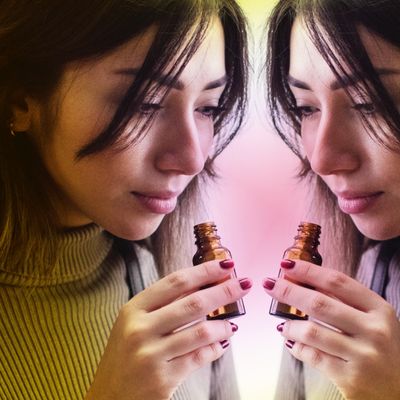
This morning, my wife and I put on the same perfume. It’s Versace Eros Pour Femme — a warm citrus-jasmine scent with base notes of peony and musk. After we spray it, the air smells the same for both of us: but when I lean in to smell her wrists there’s bergamot and burnt sugar, and she tells me I smell of lemons, jasmine, sandalwood. Skin chemistry makes a difference. The same molecules are on both of us, and yet we change them uniquely.
These days my wife mostly wears Calvin Klein Truth, and I mostly wear Andy Tauer Incense Rose, and it’s remarkable how well the scents of basil, bamboo, and lilies mix with roses, myrrh, and resins. I can’t smell Truth without thinking of her. I can’t imagine not curating my perfume collection to match well with hers. The particular and precious scent of your partner — the lovely and intoxicating combination of that scent and your own, making something new.
On the days we wear the same perfume, I feel like we’ve been married a lot longer than the year and a half we’ve got under our belts: It’s a seamless partnership that still has room for individual variation. The same molecules, different skin chemistry.
Jean-Paul Guerlain said once that perfume is the most intense form of memory. Science bears him out: scent is the strongest evoker of memory, in laboratory settings — much more than pictures. Scents send us back into the past: your grandmother’s perfume rising up from some ancient jacket like a ghost.
And scent is strongly associated with persona. Every perfume commercial wants us to believe that just spraying a smell will transform us into gauze-draped icons of femininity. Scent tells us where we came from, and perfume tells us who we want to be.
I wore my grandmother’s astrakhan coat – 1970s, real lambswool cuffs and collar — to buy my first bottle of perfume. Wearing it, I took the subway downtown in Manhattan, and walked into the Chanel flagship store like I was the sort of woman who belonged there. I was 26 and trying to imagine myself into an adulthood sophistication sufficient not only for going into a Chanel boutique, but for approaching the perfume desk in the back and asking for 100 ml. of Cuir de Russie. I bought that bottle — dusty from its high shelf, so unlike its No. 5 cousins — with the last of my graduate school stipend, and wore it every day for a year.
Cuir de Russie smells like leather and irises. When it is still wet, there’s a scrim of top-note aldehydes and bergamot; it dries down into something more primal, the scent of filthy, beautiful flowers crushed on some leather couch under a woman’s naked thighs. The year I wore it I learned that when it mixed with my sweat it could smell like something rotting, or even, on a bad day, fecal. It’s a fuck-you intellectual scent, a perfume for a woman wearing a leather jacket and last night’s eyeshadow, drinking endless cups of coffee on the steps of a university library far from her Park Avenue apartment. A woman I wanted to be.
The perfume helped. It was a way of pretending, of wrapping a scent around myself as a scaffolding for a character I hadn’t quite grown into. I wasn’t very good at being a person yet, and I needed all the supporting structure for my identity I could muster.
Later on — after the year of Cuir de Russie — I tried on a lot of personas, and a lot of perfumes. Guerlain Nahema, currants and earth, a scent for a modern-day Empress Theodora of Byzantium, a woman who knew her worth and how to prove it. Caron Yatagan, harsh and edgy-corporate in bitter green and vetiver. Serge Lutens Sarrasins, carnations and sex-laden musk, a cyberpunk party girl on the roof of a Hong Kong club, watching the lights of the city.
None of them quite me, all of them useful to pretend with, to assemble parts of the woman I wanted to be.
And then I met my wife, and she smelled like her — on our first date she was wearing Christine Dior Poison, an outrageously deliberate evocation of ’80s excess that went perfectly with her red leather trench and her hair, dyed to look like Bowie’s in The Man Who Fell to Earth. She was as designed as I was; as constructed from assembled parts as I was; and, it turned out, as obsessed with stories as I was. We’re both writers. Over the first weekend we spent together, I learned a solid truth about the woman I wanted to be: She was someone who knew the scent of another person’s skin as intimately as she knew her own.
That weekend I wore Desert Rose by Andy Tauer, the scent I wear most often now. She says it’s what she thinks of when she imagines my smell. That and my skin, my sweat. The combination of all those things. We bought perfume together, later on. She showed me the scent she’d found when she was 18 in Paris: In Love Again, the vintage one that smells perfectly of grapefruit and flowers. Her bottle was almost empty. I scoured the internet until I could give her a new bottle of the same vintage, the formula unchanged. Perfume wasn’t a solitary occupation anymore: it was a joint exploration. A series of scent-linked memories about us. Us together.
I’m still not very good at being a person. I still use perfume as a scaffold to hold myself together. But I remember the way my wife’s wrists smell next to mine, the subtle differences inside the joint experience, and I think: maybe I’m learning.

